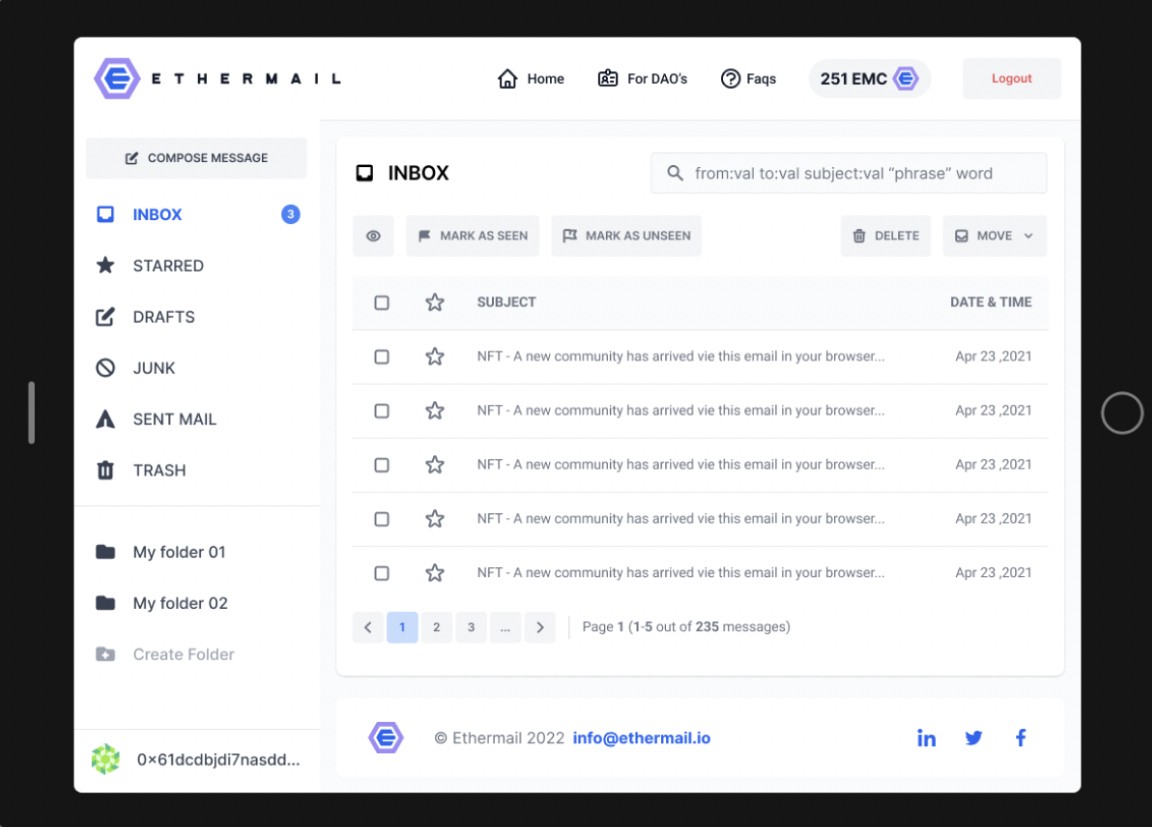Backing EtherMail: Cryptographic wallets meet email in the decentralized web
by Gleb Dudka, August 11, 2022
We are excited to be backing EtherMail as co-lead, together with Fabric, in their recent $3.25m seed funding round. EtherMail is a blockchain-agnostic email protocol that is propelling today’s email into the Web3 ecosystem, mapping any cryptographic wallet to an email address/inbox (e.g. 0x123…@ethermail.io). This allows anonymous communication to and between projects and their DAOs, token holders, NFT holders and improves Web2-Web3 social interoperability.
While initially skeptical about the longevity of email in an ever more digital future, email, we believe, could be a great shot at solving the disconnect that exists between on-chain cryptographic wallets and existing mediums of communication. As we have seen, email has persevered through all of the digital paradigm shifts and, with 320 billion emails sent every day, is prevalent as ever despite the emergence of more advanced messaging tools such as Discord or Telegram. Moreover, email is decentralized as there are several email clients that are interoperable; it is compatible with Web2 collaboration tools from MS Office to Notion and Slack; and finally, it is still more powerful and feature-rich than other existing messaging tools. As such, we believe that email will be just as integral to the Web3 world as it was in Web1 and Web2.
- Governance. Encouraging more active governance participation by updating a DAO with the latest proposals. A tool for protocol politicians to attract delegations and reach out to delegates based on their previous governance activity. Some of the votings could be also done without leaving the email client.
Community management and onboarding. The first means of communication that supports community-wide broadcasting — token issuers can welcome the buyer into the community and direct them to all relevant community resources, governance proposals and offer to sign-up for newsletters to maximize utility on both sides. - OTC platform for tokens and NFTs. Provides the opportunity to directly communicate with large token holders to negotiate an OTC deal. This is especially relevant for NFTs. Such an NFT OTC feature could also potentially even bypass platform fees on Opensea or Looksrare.
- NFT token-gating. Managing the NFT holder community and token- or NFT-gating parties, drops, merch sales, events, etc.
- Web2-Web3. Single sign-on would allow for anyone to register and log into Web2 applications (e.g Discord, Slack, etc.) with their wallet/extension like Metamask.
- User acquisition. Any given protocol can vampire attack competing protocol’s user and token holder base by directly messaging token holders with airdrop information and other aggressive marketing such as offering higher APYs for migrating liquidity.
Phishing protection. As the emails come from on-chain addresses, verification of an email sender’s authenticity is a simple task. This eliminates or at the very least greatly decreases the scope of phishing attacks.
EtherMail client and token
Every wallet by default is already tied to a virtual inbox which is waiting to be activated by initiating the EtherMail email with a wallet. This means that unlike with most competitors, one does not require both parties to have accounts before being able to message one another.
Furthermore, the EtherMail client is off-chain, which allows for simple integration with almost any other L1 chain and it is compatible with all existing email clients, from Gmail to Protonmail.
Given the goal of gradual decentralization of the email server infrastructure, third parties would become involved in running such infrastructure in form of nodes and validators. Ethermail token will be used in part to incentivize third-party participation in network infrastructure operations.
Another key feature of the protocol which the token fulfills is spam protection. Besides requiring protocol teams and businesses to spend tokens and subscribe to a certain plan, there will be spam protection measures implemented. More on the subscription plans and their commercials can be found upon their rollout.
Be part of Email 3.0 now
DAOs and Web3 project teams
With EtherMail you will be able to reach and update any anonymous token holder in a highly customized and individualized manner based on the nature of their protocol interactions, lay out incentives for token adoption, and build a decentralized community.
Users
Simply activate your EtherMail email and check what emails are waiting for you in your inbox. As the EtherMail team will announce new partnerships, you will be able to interact with some of the emails the projects send you and take part in the token distribution.
Email is the fundamental solution to facilitate anonymous wallet-to-wallet communication, one that overcomes web3’s famous UI/UX problem — email is email.
Not only has email shown resilience amongst thwarting competition in communication tech, but its message volume is still growing by 5% per year. As such, it’s been clearly demonstrated: you can’t kill email. And EtherMail will be the vehicle carrying it into a decentralized future.
To learn more about EtherMail, visit their website and create your email here.
Thanks to my colleague Ben Wendelstadt who helped write and review the blog post.
